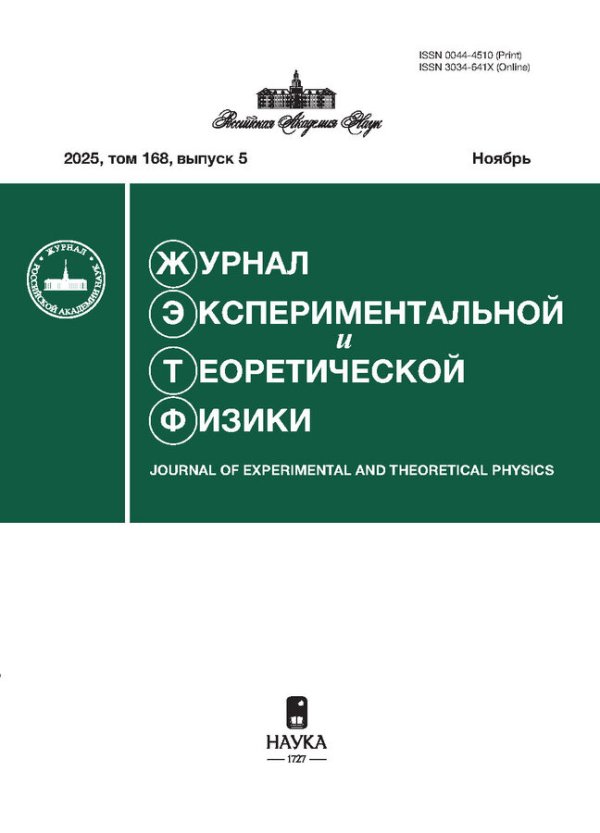RESONANT OPTICAL PUMPING OF THE ISOMER 229Th WITH ENERGY 8 eV
- Authors: Karpeshin F.F.1, Trzhaskovskaya M.B2
-
Affiliations:
- Mendeleev Institute for Metrology
- National Research Center “Kurchatov Institute” – Petersburg Nuclear Physics Institute
- Issue: Vol 165, No 2 (2024)
- Pages: 145-151
- Section: Articles
- URL: https://journal-vniispk.ru/0044-4510/article/view/256475
- DOI: https://doi.org/10.31857/S0044451024020019
- ID: 256475
Cite item
Abstract
The most likely candidate for the role of a nuclear optical standard is the isomer of the nuclear isotope 229mTh with an energy of 8.338 eV. The possibility to specify the value of this energy by resonant optical pumping through an electron bridge was discussed. Proper use of the natural atomic linewidths, which are many orders of magnitude larger than the natural nuclear isomeric linewidth, is critical. Recent studies have shown that broadening due to internal conversion in neutral thorium atoms leads to a gain in scan time of nine orders of magnitude, facilitating the search for electron-nuclear resonance to a feasible level. The reverse resonance conversion method proposed in this article is applicable to ionized thorium atoms. It has the potential to improve experimental efficiency by orders of magnitude. The implementation of this method requires simultaneous excitation of the nucleus and electron shell in the final state. The causal connection between this principle and the solution to the thorium riddle is shown.
About the authors
F. F. Karpeshin
Mendeleev Institute for Metrology
Email: fkarpeshin@gmail.com
Russian Federation, 190005, Saint Petersburg
M. B Trzhaskovskaya
National Research Center “Kurchatov Institute” – Petersburg Nuclear Physics Institute
Author for correspondence.
Email: fkarpeshin@gmail.com
Russian Federation, 188300 Gathcina, Leningrad region
References
- S. Kraemer, J. Moens, M. Athanasakis-Kaklamanakis et al. Observation of the Radiative Decay of the 229T h Nuclear Clock Isomer, Nature 617, 706 (2023); https://doi.org/10.1038/s41586-023-05894-z.
- Д.Ф. Зарецкий, Ф.Ф. Карпешин. Мезорентгеновское излучение осколков мгновенного деления, ЯФ 29, 306 (1979) [Sov. J.Nucl.Phys. 29, 151 (1979)].
- Б.А. Зон, Ф.Ф. Карпешин. Ускорение распада ядра 235U за счет резонансной внутренней конверсии, стимулированной лазерным излучением, ЖЭТФ 97, 401 (1990).
- V.A. Krutov, Ann.Phys. (Leipzig) 21, 291 (1968); В.А. Крутов, Письма в ЖЭТФ 52, 1176 (1990) [JETP Lett. 52, 584 (1990)].
- Д.П. Гречухин, А.А. Солдатов, ЯФ 23, 273 (1976).
- D. Kekez et al., Phys.Rev. Lett. 55, 1366 (1985).
- C. R¨osel, F. F. Karpeshin, P. David et al. Experimental Evidence for Muonic X-rays from Fission Fragments, Z.Phys.A 345, 425 (1993).
- F. F. Karpeshin, M. R. Harston, F. Attallah, J. F. Chemin, J. N. Scheurer, I. M. Band, and M. B. Trzhaskovskaya. Subthreshold Internal Conversion to Bound States in Highly-Ionized 125Te Ions, Phys.Rev.C 53 1640 (1996).
- E.V. Tkalya, JETP Lett. 55, 216 (1992); Nucl. Phys.A 539, 209 (1992).
- P.V. Borisyuk, N.N. Kolachevsky, A.V. Taichenachev, E.V. Tkalya, I.Yu. Tolstikhina, and V. I. Yudin. Excitation of the Low-Energy 229mT h Isomer in the Electron Bridge Process via the Vontinuum, Phys.Rev.C 100, 044306 (2019).
- A.Ya. Dzublik. Quasiclassical Theory of 229mT h Excitation by Laser Pulses via Electron Bridges, Phys.Rev.C 106, 064608 (2022).
- Ф. Ф. Карпешин, И. М. Банд, М. Б. Тржасковская. Подпороговая конверсия в 125T e45+, ЖЭТФ 116, 1565 (1999)
- Ф.Ф.Карпешин,М.Б.Тржасковская,Ю.П. Гангрский. Резонансная внутренняя конверсия в водородоподобных ионах, ЖЭТФ 126, 323 (2004).
- F. F. Karpeshin, I.M. Band, and M.B. Trzhaskovskaya. 3.5-eV isomer of 229mT h: how it can be produced, Nucl.Phys. A654, 579 (1999).
- L. Von der Wense, B. Seiferle, M. Laatiaoui et al. Direct detection of the 229T h nuclear clock transition Nature 47, 533 (2016).
- E. Peik, M. Okhapkin. Nuclear clocks based on resonant excitation of γ-transitions, C.R.Physique 16, 516 (2015).
- L. von der Wense and Z. Chuankun. Concepts for direct frequency-comb spectroscopy of 229mT h and an internal-conversion-based solid-state nuclear clock, Eur.Phys. J. Ser.D 74, 146 (2020).
- Л.Ф. Витушкин, Ю.И. Гусев, Ф.Ф. Карпешин, Ю.А. Новиков, О.А. Орлов, и др. Два механизма возбуждения ядра тория 229T h лазером как пролог к созданию ядерно-оптических часов, Законод. и Прикл.Метрология. №3, 9 (2022).
- B. Seiferle et al. Energy of the 229T h nuclear clock transition, Nature 573, 243 (2019).
- A. Kramida and Yu. Ralchenko, J. Reader and NIST ASD Team (2022), NIST Atomic Spectra Database (ver. 5.10), https://physics.nist.gov/asd.National Institute of Standards and Technology, Gaithersburg, MD; DOI: https://doi.org/10.18434/T4W30F.
- F. F. Karpeshin, S. Wycech, I.M. Band, M.B. Trzhaskovskaya, M. Pf¨utzner, and J. Zylicz. Rates of transitions between the hyperfine-splitting components of the ground-state and the 3.5 эВ isomer in 229T h89+, Phys.Rev.C 57, 3085 (1998).
- F. F. Karpeshin and L. F. Vitushkin. On the problems of creating a nuclear-optical frequency standard based on 229T h, https://doi.org/10.48550/arXiv.2307.08711
- I.M. Band and M.B. Trzhaskovskaya. Internal Conversion Coefficients for Low-Energy Nuclear Transitions, At.Data Nucl.Data Tables 55, 43 (1993).
- S.G. Porsev et al. Excitation of the Isomeric 229mT h Nuclear State via an Electronic Bridge Process in 229T h+, Phys.Rev. Lett. 105, 182501 (2010).
- F. F. Karpeshin and M.B. Trzhaskovskaya. Impact of the ionization of the atomic shell on the lifetime of the 229mT h isomer, Nucl.Phys.A 969, 173 (2018).
- F. F. Karpeshin and M.B. Trzhaskovskaya. A proposed solution for the lifetime puzzle of the 229mT h+ isomer, Nucl.Phys.A1010, 122173 (2021).
Supplementary files










